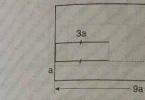A noticeable increase in the content of free oxygen in the Earth's atmosphere 2.4 billion years ago, apparently, was the result of a very rapid transition from one equilibrium state to another. The first level corresponded to an extremely low concentration of O 2 - about 100,000 times lower than what is observed now. The second equilibrium level could be reached at a higher concentration of at least 0.005 of the current one. The oxygen content between these two levels is characterized by extreme instability. The presence of such "bistability" makes it possible to understand why there was so little free oxygen in the Earth's atmosphere for at least 300 million years after cyanobacteria (blue-green "algae") began to produce it.
Currently, the Earth's atmosphere is 20% free oxygen, which is nothing more than a by-product of photosynthesis of cyanobacteria, algae and higher plants. A lot of oxygen is released by tropical forests, which are often called the lungs of the planet in popular publications. At the same time, however, it is silent that during the year tropical forests consume almost as much oxygen as they produce. It is spent on the respiration of organisms that decompose the finished organic matter, primarily bacteria and fungi. For, in order for oxygen to begin to accumulate in the atmosphere, at least part of the substance formed during photosynthesis must be removed from the cycle- for example, get into bottom sediments and become inaccessible to bacteria that decompose it aerobically, that is, with oxygen consumption.
The overall reaction of oxygenic (that is, "oxygen-giving") photosynthesis can be written as:
CO 2 + H 2 O + hν→ (CH 2 O) + O 2,
where hν is the energy of sunlight, and (CH 2 O) is the generalized formula of organic matter. Breathing is the reverse process, which can be written as:
(CH 2 O) + O 2 → CO 2 + H 2 O.
In this case, the energy necessary for organisms will be released. However, aerobic respiration is possible only at an O 2 concentration not less than 0.01 of the current level (the so-called Pasteur point). Under anaerobic conditions, organic matter decomposes by fermentation, and methane is often formed at the final stages of this process. For example, the generalized equation for methanogenesis through the formation of acetate looks like:
2(CH 2 O) → CH 3 COOH → CH 4 + CO 2.
If we combine the process of photosynthesis with the subsequent decomposition of organic matter under anaerobic conditions, then the total equation will look like:
CO 2 + H 2 O + hν→ 1/2 CH 4 + 1/2 CO 2 + O 2.
It was this way of decomposition of organic matter, apparently, that was the main one in the ancient biosphere.
Many important details of how the modern equilibrium between the supply of oxygen to the atmosphere and its removal were established remain unclear. After all, a noticeable increase in oxygen content, the so-called “Great Oxidation of the Atmosphere” (Great Oxidation), occurred only 2.4 billion years ago, although it is known for certain that cyanobacteria that carry out oxygenic photosynthesis were already quite numerous and active 2.7 billion years ago, and they arose even earlier - perhaps 3 billion years ago. Thus, during for at least 300 million years, the activity of cyanobacteria did not lead to an increase in the oxygen content in the atmosphere.
The assumption that, for some reason, a radical increase in net primary production (that is, an increase in organic matter formed during the photosynthesis of cyanobacteria) suddenly occurred, did not stand up to criticism. The fact is that during photosynthesis, the light isotope of carbon 12 C is mainly consumed, and in environment the relative content of the heavier 13C isotope increases. Accordingly, bottom sediments containing organic matter should be depleted in the 13C isotope, which accumulates in water and goes to the formation of carbonates. However, the ratio of 12 С and 13 С in carbonates and in organic matter sediment remains unchanged despite drastic changes in the concentration of oxygen in the atmosphere. This means that the whole point is not in the source of O 2, but in its, as geochemists put it, “sink” (withdrawal from the atmosphere), which suddenly significantly decreased, which led to a significant increase in the amount of oxygen in the atmosphere.
It is usually believed that immediately before the "Great Oxidation of the Atmosphere" all the oxygen formed then was spent on the oxidation of reduced iron compounds (and then sulfur), which were quite numerous on the Earth's surface. In particular, then the so-called "banded iron ores" were formed. But recently, Colin Goldblatt, a PhD student in the School of Environmental Sciences at the University of East Anglia (Norwich, UK), together with two colleagues from the same university, came to the conclusion that the oxygen content in earth's atmosphere can be in one of two equilibrium states: it can be either very small - about 100 thousand times less than now, or quite a lot (although from the position of a modern observer it is small) - no less than 0.005 of the current level.
In the proposed model, they took into account the entry into the atmosphere of both oxygen and reduced compounds, in particular, paying attention to the ratio of free oxygen and methane. They noted that if the oxygen concentration exceeds 0.0002 of the current level, then part of the methane can already be oxidized by methanotrophic bacteria according to the reaction:
CH 4 + 2O 2 → CO 2 + 2H 2 O.
But the rest of the methane (and there is quite a lot of it, especially at low oxygen concentrations) enters the atmosphere.
The whole system is in a non-equilibrium state from the point of view of thermodynamics. The main mechanism for restoring disturbed equilibrium is the oxidation of methane in the upper layers of the atmosphere by a hydroxyl radical (see Methane fluctuations in the atmosphere: man or nature - who wins, "Elements", 06.10.2006). The hydroxyl radical is known to be formed in the atmosphere under the action of ultraviolet radiation. But if there is a lot of oxygen in the atmosphere (at least 0.005 of the current level), then an ozone screen is formed in its upper layers, which well protects the Earth from harsh ultraviolet rays and at the same time interferes with the physicochemical oxidation of methane.
The authors come to the somewhat paradoxical conclusion that the existence of oxygenic photosynthesis in itself is not a sufficient condition either for the formation of an oxygen-rich atmosphere or for the formation of an ozone screen. This circumstance should be taken into account in those cases when we are trying to find signs of the existence of life on other planets based on the results of a survey of their atmosphere.
Formation of the atmosphere. Today, the Earth's atmosphere is a mixture of gases - 78% nitrogen, 21% oxygen and a small amount of other gases, such as carbon dioxide. But when the planet first appeared, there was no oxygen in the atmosphere - it consisted of gases that originally existed in the solar system.
Earth came into being when small rocky bodies, made up of dust and gas from the solar nebula, known as planetoids, collided with each other and gradually took on the shape of a planet. As it grew, the gases contained in the planetoids burst out and enveloped Earth. After some time, the first plants began to release oxygen, and the primordial atmosphere developed into the current dense air shell.
Origin of the atmosphere
- A rain of small planetoids hit the nascent Earth 4.6 billion years ago. The gases of the solar nebula, enclosed inside the planet, escaped on collision and formed the primitive atmosphere of the Earth, consisting of nitrogen, carbon dioxide and water vapor.
- The heat released during the formation of the planet is retained by a layer of dense clouds of the primordial atmosphere. "Greenhouse gases" - such as carbon dioxide and water vapor - stop heat from being emitted into space. The surface of the Earth is flooded with a seething sea of molten magma.
- When planetoid collisions became less frequent, the Earth began to cool and oceans appeared. Water vapor condenses from thick clouds, and rain, lasting several eons, gradually floods the lowlands. Thus the first seas appear.
- The air is purified as water vapor condenses and forms oceans. Over time, carbon dioxide dissolves in them, and the atmosphere is now dominated by nitrogen. Due to the lack of oxygen, a protective layer is not formed. ozone layer, and the ultraviolet rays of the sun freely reach the earth's surface.
- Life appears in the ancient oceans within the first billion years. The simplest blue-green algae are protected from ultraviolet radiation sea water. They use to generate energy sunlight and carbon dioxide, while oxygen is released as a by-product, which gradually begins to accumulate in the atmosphere.
- Billions of years later, an oxygen-rich atmosphere forms. Photochemical reactions in the upper atmosphere create a thin layer of ozone that scatters harmful ultraviolet light. Life can now move out of the oceans onto land, where many complex organisms emerge as a result of evolution.

Billions of years ago, a thick layer of primitive algae began to release oxygen into the atmosphere. They have survived to this day as fossils called stromatolites.

Volcanic origin

1. Ancient, airless Earth. 2. Eruption of gases.
According to this theory, volcanoes actively erupted on the surface of the young planet Earth. The early atmosphere probably formed when the gases trapped in the planet's silicon shell escaped through the nozzles of volcanoes.
Accumulation of O 2 in the Earth's atmosphere:
1
. (3.85-2.45 billion years ago) - O 2 was not produced
2
. (2.45-1.85 billion years ago) O 2 was produced but absorbed by the ocean and seafloor rocks
3
. (1.85-0.85 billion years ago) O 2 leaves the ocean, but is consumed by the oxidation of rocks on land and the formation of the ozone layer
4
. (0.85-0.54 billion years ago) all rocks on land are oxidized, the accumulation of O 2 in the atmosphere begins
5
. (0.54 billion years ago - present) modern period, the content of O 2 in the atmosphere has stabilized
Oxygen catastrophe(oxygen revolution) - a global change in the composition of the Earth's atmosphere that occurred at the very beginning of the Proterozoic, about 2.4 billion years ago (siderian period). The result of the oxygen catastrophe was the appearance of free oxygen in the atmosphere and a change general atmosphere from reducing to oxidizing. The assumption of an oxygen catastrophe was made on the basis of a study of a sharp change in the nature of sedimentation.
Primary composition of the atmosphere
The exact composition of the Earth's primary atmosphere is currently unknown, but it is generally accepted that it was formed as a result of degassing of the mantle and was of a restorative nature. Its basis was carbon dioxide, hydrogen sulfide, ammonia, methane. This is evidenced by:
- non-oxidized sediments visibly formed on the surface (for example, river pebbles from oxygen-labile pyrite);
- no known significant sources of oxygen and other oxidizing agents;
- study of potential sources of the primary atmosphere (volcanic gases, composition of other celestial bodies).
Causes of the oxygen catastrophe
The only significant source of molecular oxygen is the biosphere, more precisely, photosynthetic organisms. Appearing at the very beginning of the existence of the biosphere, photosynthetic archaebacteria produced oxygen, which was almost immediately spent on the oxidation of rocks, dissolved compounds and atmospheric gases. A high concentration was created only locally, within the bacterial mats (the so-called "oxygen pockets"). After the surface rocks and gases of the atmosphere turned out to be oxidized, oxygen began to accumulate in the atmosphere in a free form.
One of the probable factors that influenced the change of microbial communities was the change chemical composition ocean caused by the extinction of volcanic activity.
Consequences of an oxygen catastrophe
Biosphere
Since the vast majority of organisms of that time were anaerobic, unable to exist at significant oxygen concentrations, a global change of communities occurred: anaerobic communities were replaced by aerobic ones, previously limited only to "oxygen pockets"; anaerobic communities, on the contrary, were pushed into "anaerobic pockets" (figuratively speaking, "the biosphere turned inside out"). Subsequently, the presence of molecular oxygen in the atmosphere led to the formation of an ozone screen, which significantly expanded the boundaries of the biosphere and led to the spread of more energetically favorable (compared to anaerobic) oxygen respiration.
Lithosphere
As a result oxygen catastrophe almost all metamorphic and sedimentary rocks, which make up most of earth's crust, are oxidized.




